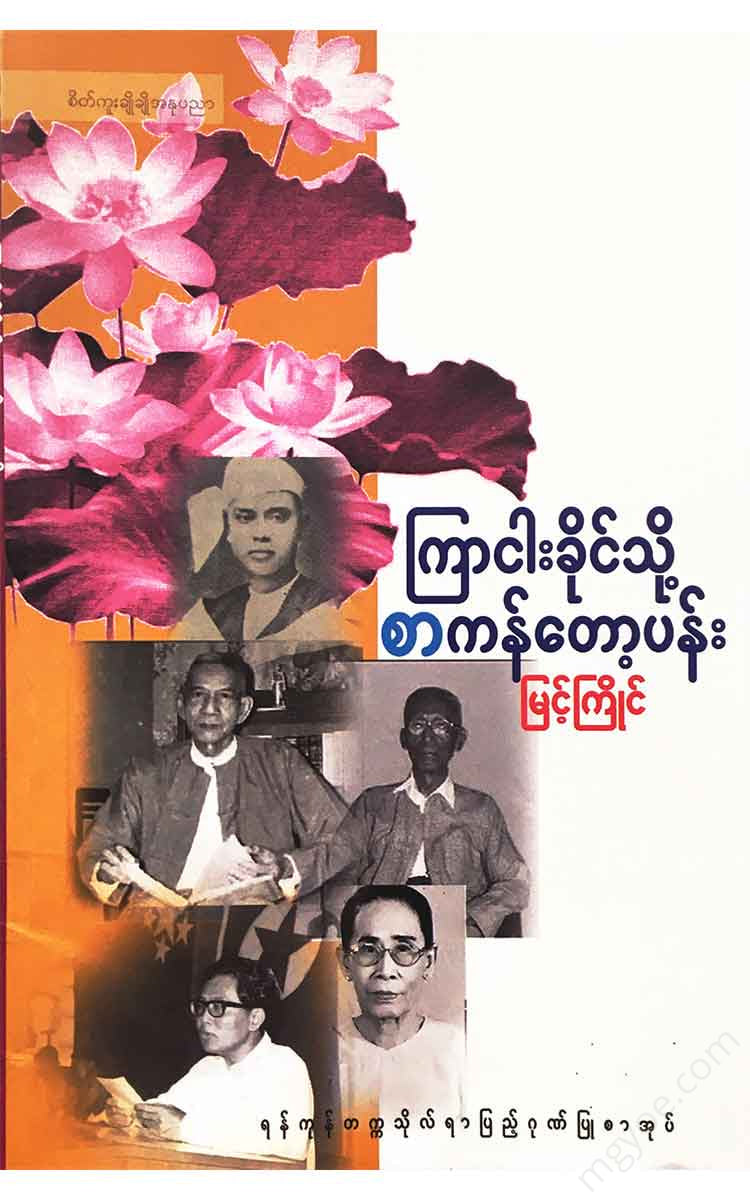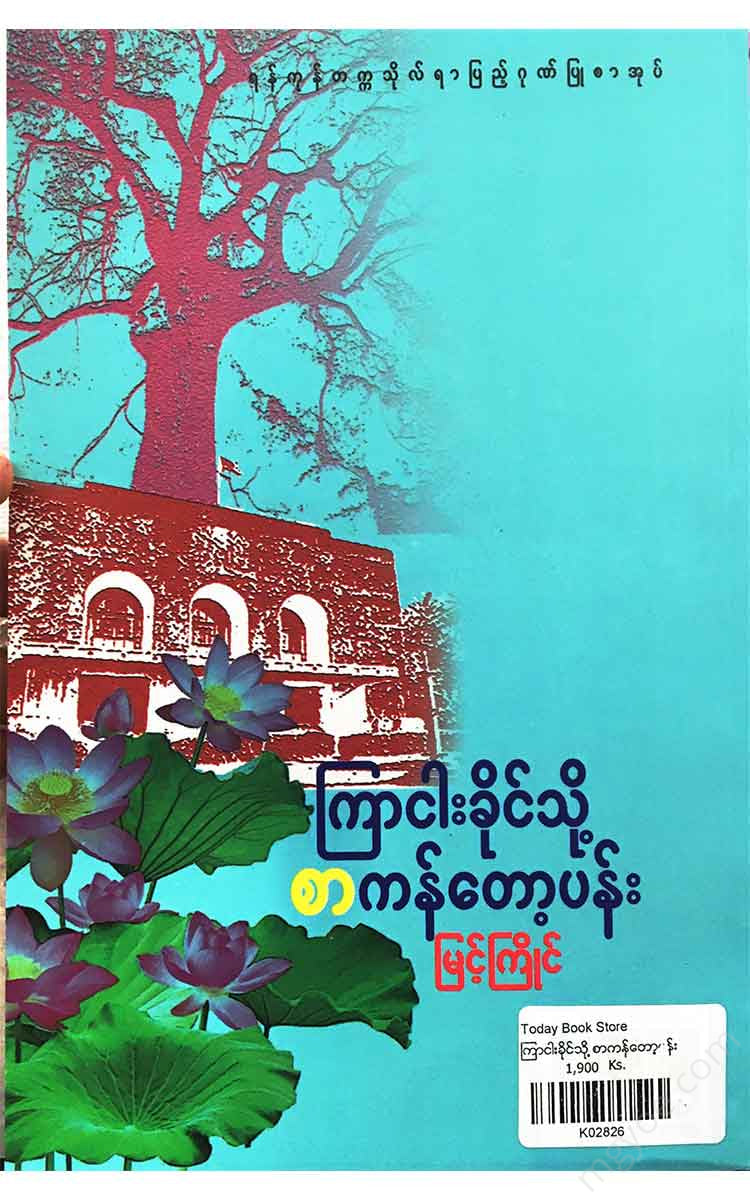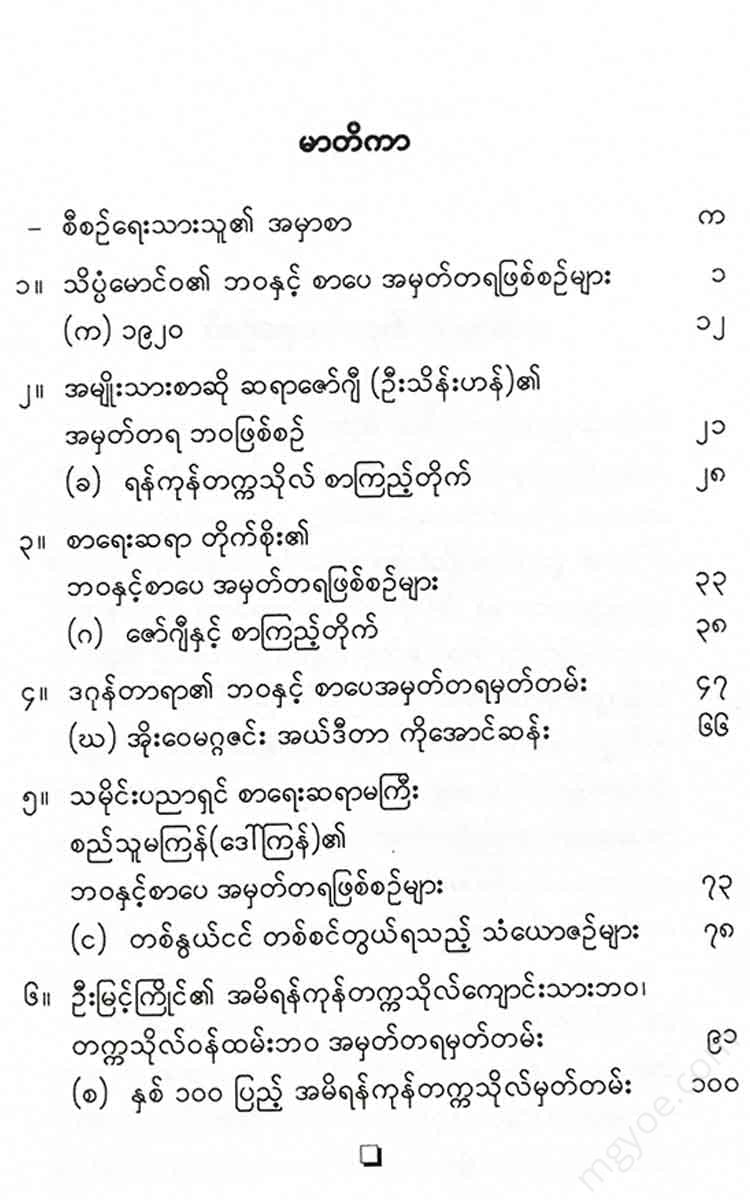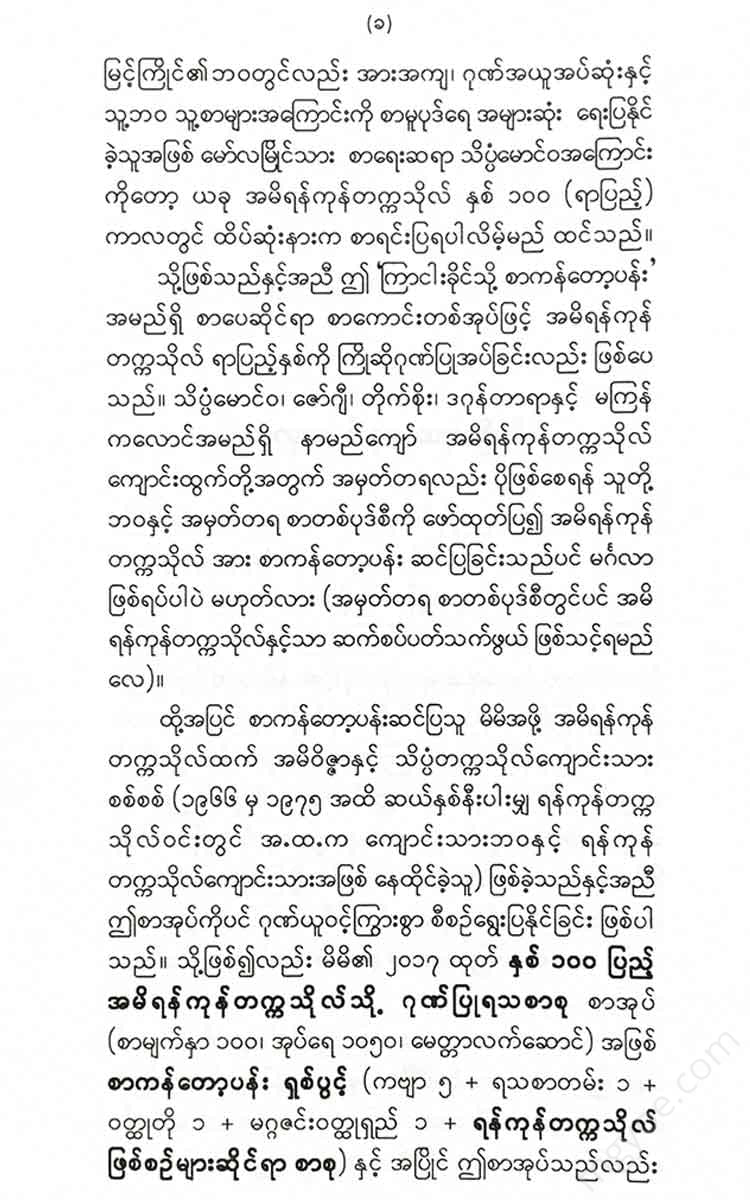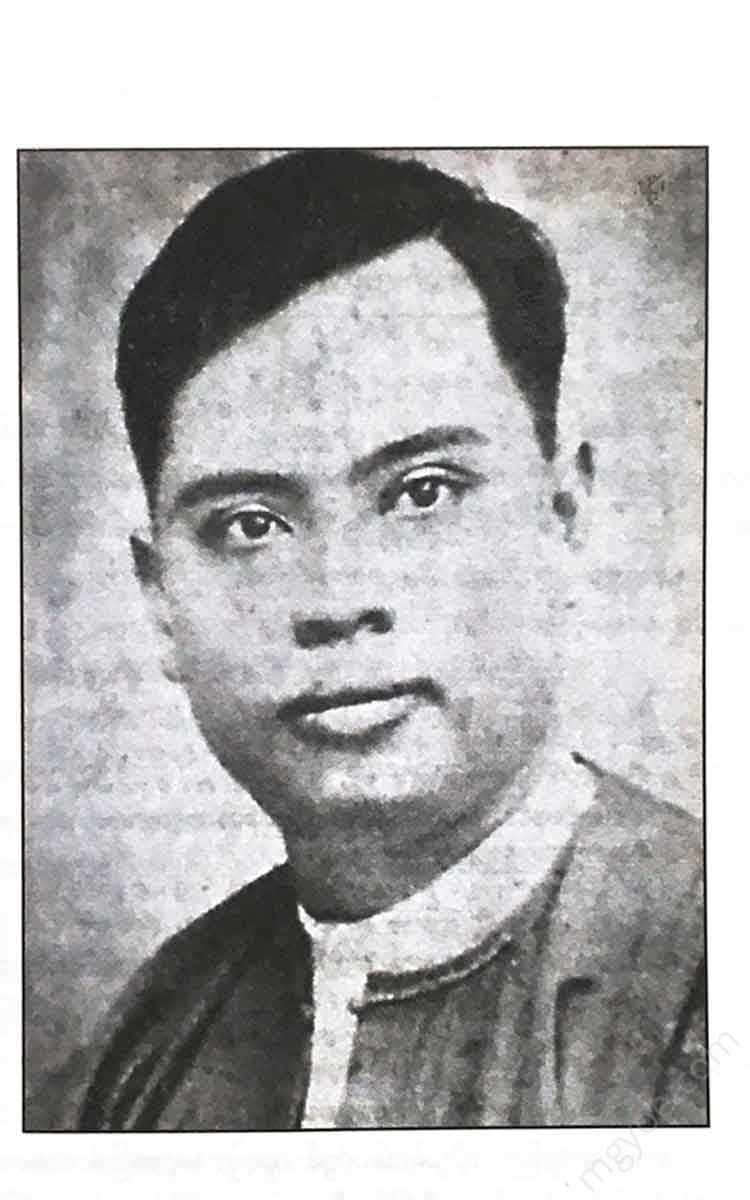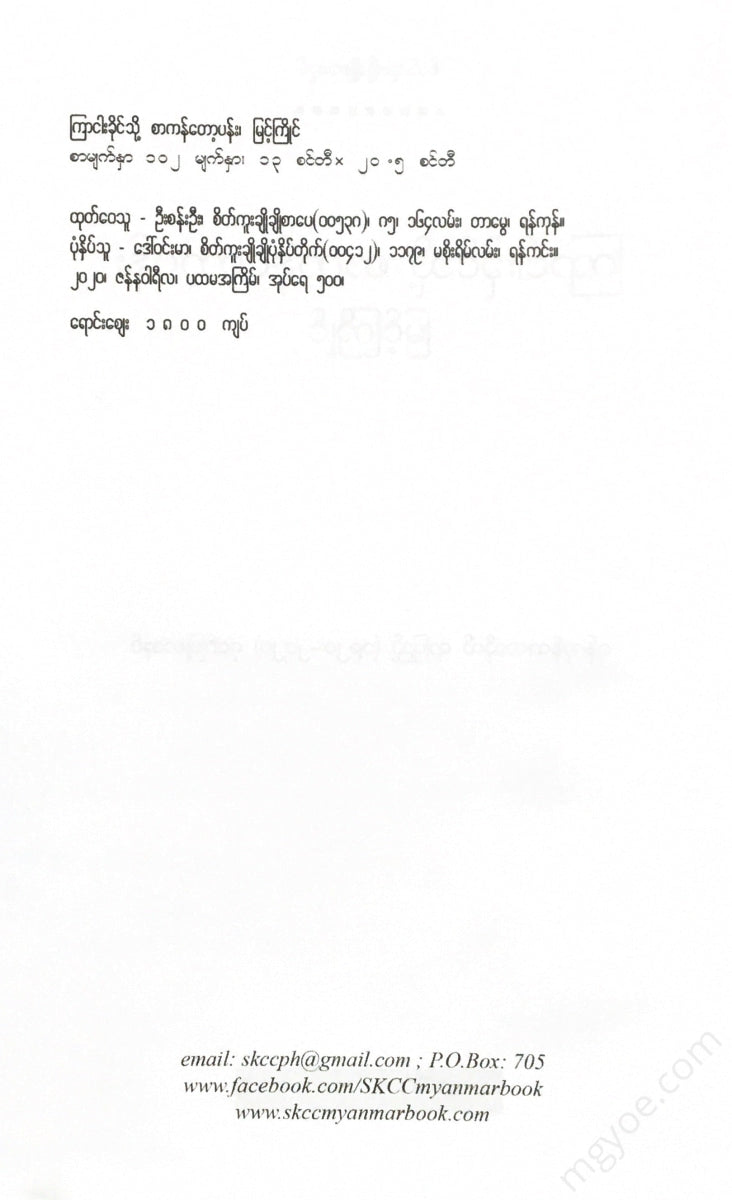စိတ်ကူးချိုချိုစာပေ
Myint Kyaing - The lotus flower is a symbol of the lotus flower.
Myint Kyaing - The lotus flower is a symbol of the lotus flower.
Couldn't load pickup availability
The following list of the works of the great contemporary writer, Sang Maung Wa (U Sein Tin, BA-Myanmar Honors First Class, ICS, Secretary) was compiled (1973-1975) and until the centenary of Sang Maung Wa (1998-99).
1. 13 books of the whole family
2. Sketches featuring Maung Lu Aye
3. 13 articles about Maung Lu Aye's novels without the protagonist's name
4. 3 long travel articles
5. 106 literary articles
6. 56 letter articles
7. 25 plays
8. 47 general writings
What is unique about the great writer, Sangmaung Maung Wa, is that he has been able to study and investigate the number of pen names from 52 at the time of compiling the collection, and 57 during the centenary of Sangmaung Maung Wa, to 60 today, based on accurate documentary evidence (especially Sangmaung Maung Wa's unprinted manuscripts). In any case, the desire to study and investigate Sangmaung Maung Wa's collection for more than forty-five years (1973-2019) has now revealed something noteworthy.
While studying the writings of Sain Maung Wa, I came to see the life and literary spirit of Sain Maung Wa together, which made me make a remark. According to the printed form of Sain Maung Wa, he wrote under the pen name Wazira Tint (Wazira means diamond, and Sein Tint is a variation of his name) in the newspapers of that time (Thuriya, Myanmar Light) in 1919. However, the first printed evidence of Sain Maung Wa is only two manuscripts published in September 1925 (one English manuscript + one Burmese manuscript), so Sain Maung Wa’s writing career is only considered to be 1925-41. Therefore, in the 16 years of writing, the writer Sain Maung Wa wrote a total of 498 manuscripts, and during his lifetime, he managed to publish 4 complete books, one of which he edited and two separate books were written and published. Today, his total number of books is 43.
While studying the writings of the great writer, Sang Maung Wa, I have also come across some comments on his life, his literature, and his writing ability during his 16 years of writing. This means that Sang Maung Wa wrote the most in 1935, and in 1927, he only wrote and published one piece. If we carefully compare the life of Sang Maung Wa and his literary career, I think we will find other comments as well. For example, the first writings were not found until 1919 (when Wazira Tint began writing), and there were no printed documents at all. (Including rare Burmese newspapers, Sang Maung Wa himself was a 1921 National School teacher who could not write, and a 1924 IA Award winner and a university student who tried his hand at writing. In parentheses.)
During the period of his graduation (BA, first class honours) in 1925-1927, he started writing one or two articles. In particular, the evidence that he wrote about 70 articles on literature from the College Magazine and the Poet's Eye Magazine, and sent them to the Yangon Thuriya Newspaper from Oxford University in England, is not evidence that he wrote professionally during 1927-1929. It can be said that the period of his most important writing and the highest number of articles was the years 1934-35. In particular, he wrote 16 articles in October 1935, which is a remarkable writer. In particular, he wrote 13 articles in 13 separate pens in the Kyabgyar Magazine, Volume 4, No. 1 (October 1935). Although there are three or four unproven pen names, there is no evidence, and I used to know that it was written by the pen name of Sing Maung Wa. In fact, in October and November 1935, he was the assistant editor of Ganda Lok Magazine, and not only did he publish the first volume of the Modern Tales and the first edition of the Oxford University Press, but he was also actively involved in the Myanma Daily's struggle for modern literature with pen names.
There is good evidence that in 1934, Maung Wa published 40 manuscripts, in 1935, 72 manuscripts, and in 1936, 50 manuscripts.
In any case, the good evidence that the writer Sain Maung Wa, who was born in June (Monday, 5-6-1899) and died in June (Saturday, 6-6-1942), was able to write even after his death is his famous war diary. The historical account of a Burmese officer who wrote from 5-1-1942 to 5-6-1942 was first published in 1966 (Pagan Book Publishing), secondly in 2002 by Myananda Book Publishing, and secondly in 2010 (Kyawthon Cho Cho Book Publishing), but in fact it was published for the third time (three times). Moreover, it was translated and sold in English at a price of 24 US dollars. The main thing to write is that the writer Sain Maung Wa was able to show his pen skills until 1942, right?
This article on the life of the great writer, U Sein Tin, is being presented in a series of edited and supplemented versions, as follows, with additional information discovered regarding the falsely written and published articles about the life of the great writer, U Sein Tin. (The article was edited and supplemented in the July 2013 issue of the film Song of Songs.)
(a) Memories of life events
1899 - Born on June 5 (Monday) to U Ohn Shwe, a clerk at the Phu Car Company, and Daw Thit, from Mupun Nat Island, Mawlamyine. He was the second (middle) of three sons. His younger name was Maung Sein Tint.
1905 (approx.) 1919 - Started school at Sayar U Chit Hla Kyaung, Mupun Yat. Then moved to St. Augustine's Society for the Propagation of the Gospel (SGS) Missionary School in Maungan Yat, where he studied in both English and Burmese until he passed the seventh grade. - When he reached the eighth grade, he moved to Shin Maha Buddha Ghotha Kyaung (now A.H.K. 9) in Mawlamyine.
1920 - Passed the tenth grade examination with distinction in Burmese and Pali. Then, he became a junior student of Maung Mae Thit Lwin College of Science, and a junior student of the Department of Mathematics (ISC Junior). The first student uprising broke out.
1920-23 - Worked as a teacher at the Central National School in Bahan Kyaw Taung and Thayet Taw Monastery.
1923 - After the strike, he studied at the College of Science as an IA Junior.
1924-25 - Pyay Kyaw Sang, Room No. 22, Student Life... - Received the Tha Do Aung Medal, awarded to the first prize winner in Burmese language in the IA Higher Secondary Examination, and the College Pali Medal, awarded to the first prize winner in Pali language. In addition, he received a monthly allowance of 20 kyats from the principal and a two-year scholarship. After the completion of two years, he received another monthly allowance of 25 kyats from the government.
1926 - The 6 students selected for the first year of the Yangon University College (Tagaung Hall, Room No. 137, Day School) were Maung Sein Tin, Maung Ba Thein, U Ko Gyi, Maung Hla Khin, Maung Kalay, Maung Bo, and instructor U Kyin. Maung Bo (Maung Bo) is known to be the father of U Luni, the retired Rector of Mandalay University.
1927 - Passed the BA examination with first class honours in Burmese and was awarded the Dally Jamshedji Chinai Silver Medal . Then, with the efforts of Professor U Pe Maung Tin, he was the only student of that year to study in the Burmese honours class and passed the first class with first class. Then, he continued his MA course by teaching as a tutor in Burmese at the University College Science School.
1927-29 - After five months as a tutor, he set sail for England on the Sagaing ship from Yangon port on Monday, August 22, 1927. He was offered the position of ICS in the Indian Civil Service and was allowed to study at Christ Church College, Oxford University, England.
1929 - Returned from England to Myanmar (Rangoon) on 3-12-1929. On 5-12-1929, he returned to his hometown, Mawlamyine, for a 6-day leave. - On 9-12-1929 (Monday), he started serving as an ICS employee (intern) in Sagaing. He started receiving a salary of 450 kyats.
1930 - Married Ma Hla Than, the second daughter of U Chit Su and Daw Thein Yin, a resident of No. 108, Dai Wun Kwin, Mawlamyine, on 1-12-1930 (Monday). They were together for only 9 months before Ma Hla Than passed away due to ill health.
1932 - U Soe Gyi, a rice mill owner from Kyaik Latt, married Ma Khin Myint (Khin Khin Myint also known as Daw Khin Than Myint), daughter of Daw Chit, on 15-1932 (Sunday). They had a son, Tin Maung Myint (Maung Hmwe also known as Maung Lu Hmwe), and daughters, Tin May Myint and Tin Swe Myint. Daw Khin Khin Myint died on 27-1991 at the age of 77. Her younger daughter, Daw Tin Swe Myint (Mae Kay), died on 24-9-2012 at the age of 72.
1929-42 - Served as a government employee (government employee) in various positions such as town manager, district assistant, deputy secretary, and other positions in Sagaing, Meikthila, Minbu, Hinthada, Zalun, Myaungmya, Nyaungdon, Yangon (Insein), Salin, Kyaukse, Shwebo, and Mandalay, a total of 12 towns. - Died on Saturday, June 6, 1942, at the hands of bandits in Gatha village, about ten miles east of Kandal, Shwebo district. (Revised and supplemented article from Thoughts, No. 80, June-July, 1992.)
(b) Memoirs of a writer
1919 - Before graduating from the tenth grade, he began writing for newspapers under the pen name "Wazira Tint".
1925 - His earliest English-language articles under the pseudonym X appear in the University College Magazine.
1926-27 - Before becoming a modernist, he wrote articles in the University College Magazine and the Poet's Eye Magazine under the real name "Maung Sein Tin".
1927-29 - Under the pen name "Maung Myathwin", a science student at Oxford University in England, he wrote more than 70 articles on Burmese literature for the Yangon Thuriya Daily newspaper.
1933 - The novel "Hla Om Mae" was published as a complete work in the Ganthaloka magazine as a series of contemporary literary works. The novel "Hla Om Mae" is the only Burmese novel written by a scholar.
1933-38 - He wrote articles in the form of letters, such as "Letters from Bagan" in the Thuriya Ruikwon Pura and Thuriya Pura, and "Letters from Maung Than Chaung" in the October 1934 issue of the Kyabgyar Magazine, and in the form of various letters in the Ganthaloka Magazine from November 1938. He also wrote travelogue articles on subjects such as Setuttara, Ye Ra Mann, and Oxford University Records in the Ganthaloka Magazine.
1934 - The first play written under the name Tin Tint, "Do Ba", was published in the February issue of the magazine "Prosperity". A rare poem, "Thingyan Gift", written by Maung Maung Wa, which can be called a single four-line poem, was published in the May issue of the magazine "Ganthaloka". He edited and wrote the introduction to Shwe Taung Thiha Tu's "Radana Kye Mon", published as Book 35 for the Myanmar Research Association.
1935 - The book "The First Volume of Contemporary Literature Stories" edited and published by U Pe Maung Tin as the second volume of Contemporary Literature, included 11 manuscripts by Sing Maung Wa. His famous "Oxford University Travelogue", which was published as a textbook, was published for the first time. He led the fight against the hermit U Sindar and the Burmese Daily Newspaper under five different pen names in the battle that can be called the Contemporary Literature Battle. He served as the associate editor of Ganthaloka Magazine in October and November. He single-handedly edited 16 manuscripts under various pen names in the October issue of Kyabgye Magazine (Volume 4, No. 1).
1938 - He published 31 manuscripts of his own work as the second volume of "The Tale of the Contemporary" as part of the 5th series of contemporary literary works, with the reference to his son U Tin Maung Myint (Maung Lu Hmwe).
1939 - When writer Nyo Mya was about to go to England as a government scholar to study journalism and communication, he wrote an article titled “Nyo Mya” in the book “A Farewell Letter to Nyo Mya Going West” published by the government. In addition, Maung Maung Wa wrote an introduction to the book titled Nyo Mya (a collection of Nyo Mya’s English-Burmese novel articles) in the Myanmar Times dated 1-8-39.
1939-42 - He wrote a war diary until his death on June 6, 1942, when he died in a state of relative peace.
Cherry Magazine, No. 78, June, 1992
Special note
The writings of the scholar Maung Wa were printed as separate monographs, and there are 43 books in total that have survived to this day.
Myint Kyaing (Aung Moe Saung) - Written and edited by -
The 120th anniversary of the founding of the University of Myanmar and his collection of writings,
Literary Travelers' Library, August 2019
The article from the book has been slightly edited and supplemented.
Myint Kyaing
16-12-2019
*
*
*//
